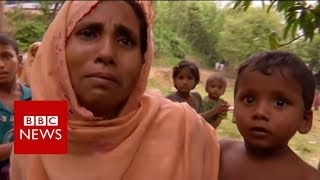Sunday, 11 January, 2026г.
















Где искать: по сайтам Запорожской области, статьи, видео ролики
пример: покупка автомобиля в Запорожье
Burma ke Musalmano par zulam ke bare me tareekhi video | Rohingya, The Most Persecuted People
The Rohingya people (/ˈroʊɪndʒə/, /ˈroʊhɪndʒə/, /ˈroʊɪŋjə/, or /ˈroʊhɪŋjə/; also termed Arakan Indians[19]) are a stateless[20] Indo-Aryan people from Rakhine State, Myanmar. There are an estimated 1 million Rohingyas living in Myanmar, and up to another million refugees and migrants abroad.[21] The majority of them are Muslim while a minority are Hindu.[22][23][24][1][25][26] Described by the United Nations in 2013 as one of the most persecuted communities in the world,[27][28][29] most of the Rohingya population are denied citizenship under the 1982 Burmese citizenship law,[30][31][32] which restricts full citizenship to British Indian migrants who settled after 1823.[32] According to Human Rights Watch, the law "effectively deny to the Rohingya the possibility of acquiring a nationality. Despite being able to trace Rohingya history to the 8th century, Burmese law does not recognize the ethnic minority as one of the national races."[32] The Rohingyas are also restricted from freedom of movement, state education and civil service jobs in Myanmar.[32][33] The Rohingyas have faced military crackdowns in 1978, 1991–1992,[34] 2012, 2015 and 2016–2017. UN officials have described Myanmar's persecution of the Rohingya as ethnic cleansing,[35] while there have been warnings of an unfolding genocide.[36] Yanghee Lee, the UN special investigator on Myanmar, believes the country wants to expel its entire Rohingya population.[37]
Migration from the Indian subcontinent to Myanmar (formerly Burma) had taken place for centuries, including as part of the spread of Buddhism, Hinduism and Islam in the region. The historical region of Bengal (now divided between Bangladesh and the Indian state of West Bengal) has historical and cultural links with Rakhine State (formerly Arakan). Bengali-speaking settlers are recorded in Arakan since at least the 17th century,[38] when the Kingdom of Mrauk U reigned. The Rohingya language shares similarities with the Chittagonian dialect of Bengali. The term Rohingya, in the form of Rooinga, was recorded by the East India Company as early as 1799, but Burmese nationalists dispute its origins.[39] Indian migration increased during the period of British rule in Burma, as Burma was a part of British India until 1937.[40] Arakan had the largest percentage of British Indians in Burma.[41] British Indians in Arakan were involved in agriculture and trade. Their presence was resented by many in the Rakhine majority. "wikipedia"
This video is about myanmar muslims called rohingya, burma muslims complete history.
Haqaiq Info is educational, motivational, informational and inspirational YouTube Channel. Abdul Basit Rahi has been created this channel. He aims to create this channel to educate the people by creating useful content. He is the editor of weekly Haqaiq News.
Like us on Facebook:
https://www.facebook.com/haqaiqinfo
Our Website:
haqaiq.news
Follow me on
Twitter: basit.rahi
Find me on Google Plus:
https://plus.google.com/u/1/+BasitRahi
Теги:
haqaiq haqaiq news haqiaq info haqaiqinfo haqiaq infor urdu documentary hindi documentary urdu history Entertainment and Information Burma muslims Rohingya myanmaar muslims
Похожие видео
Мой аккаунт


 У вашего броузера проблема в совместимости с HTML5
У вашего броузера проблема в совместимости с HTML5


